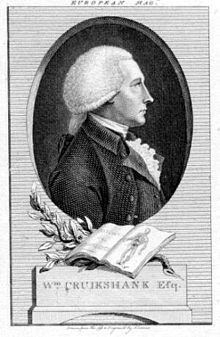Name William Cruickshank Role Chemist | Discovered Strontium | |
 | ||
Died 1810, Scotland, United Kingdom | ||
William Cruickshank (died 1810 or 1811) was a Scottish military surgeon and chemist, and professor of chemistry at the Royal Military Academy, Woolwich.
Contents
William Cruickshank was awarded a diploma by the Royal College of Surgeons of England on 5 October 1780. In March 1788 he became assistant to Adair Crawford at the Royal Military Academy, Woolwich, at a salary of £30 a year. On 24 June 1802, he became a Fellow of the Royal Society (FRS).
Strontium
Some authors credit Cruickshank with first suspecting an unknown substance in a Scottish mineral, strontianite, found near Strontian, in Argyleshire. Other authors name Adair Crawford for the discovery of this new earth, due to the mineral's property of imparting a redding color to a flame. It was later isolated by Humphry Davy and is now known as strontium.
Diabetes
Cruikshank worked with John Rollo at Woolwich in the 1790s, and some of his discoveries about diabetes were published in Rollo's book on the dietary treatment of the condition. This research led him to isolate urea in 1798, though his priority was not recognised at the time.
Trough battery
Circa 1800, Cruickshank invented the Trough battery, an improvement on Alessandro Volta's voltaic pile. The plates were arranged horizontally in a trough, rather than vertically in a column.
Retirement and death
In March 1803, Cruickshank became very ill and it is possible that this was due to exposure to phosgene during his experiments. On 6 July 1804, he retired on a pension of 10 shillings a day. He died in 1810 or 1811 and military records state that the death occurred in Scotland.
